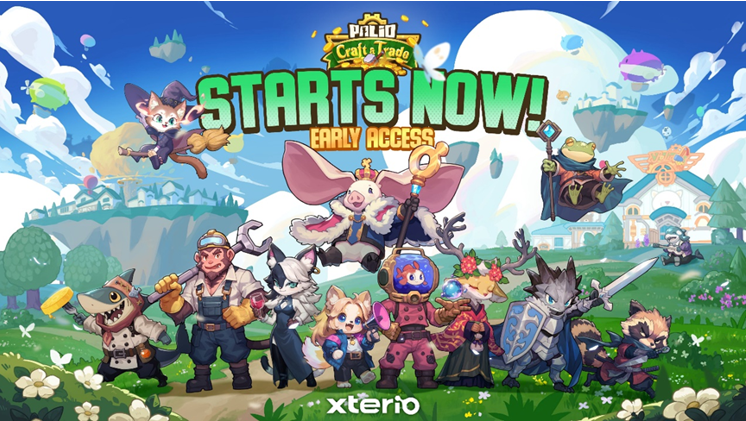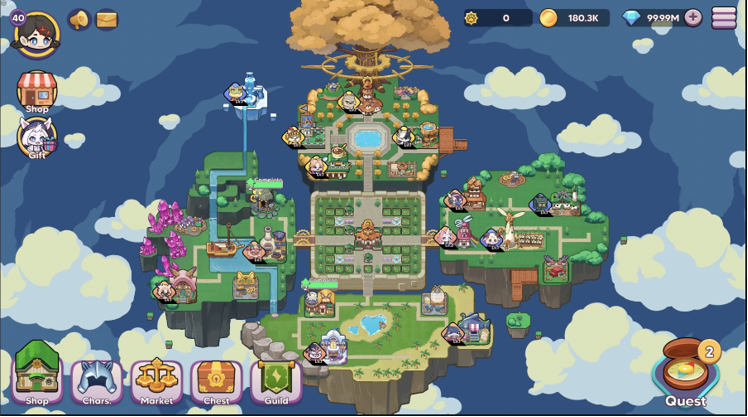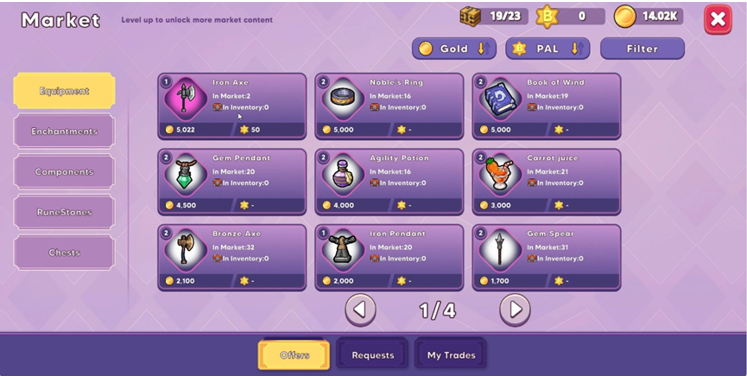The Web3 simulation business game Palio uses an AI Agent engine to create a new paradigm of virtual economy. Through AGI-driven dynamic memory system and multimodal interaction technology, it realizes NPC independent decision-making and intelligent game of assets on the chain.
When technology giants hit the boundaries of AI technology with the US$500 billion Stargate project, a more practical answer has been quietly born in the Web3 field-Xterio’s AI simulation business game Palio passed a limited number test in cooperation with the OKX Web3 wallet., using the interactive NPC economic system to deliver an innovative model for AI business scenarios.
In this test, after in-depth experience through the invitation code issued by OKX, the author found that when an AI Agent named Patoshi suddenly visited the player store, an intelligent game about equipment pricing began. This NPC with dynamic learning capabilities can not only analyze trading history and adjust strategies, but even allow players to trade equipment at a premium of 500%(the highest community record reaches 1000%), which visually confirms Palio’s core breakthrough-realizing AI Agents ‘intelligent management of assets on the chain.

Through its innovative interactive NPC economic system, it has delivered an innovative answer to CZ (Binance founder Zhao Changpeng)’s question of how AI creates real business scenarios. This design is not a simple technical build-up, but through the deep integration of AI Agents and the on-chain economy, it verifies the closed-loop value of AI in the virtual economy.

Behind this Wall Street-level virtual negotiation is Palio’s innovation of the traditional game paradigm: When AI Agents are no longer just puppets of preset scripts, but on-chain economic participants with independent decision-making capabilities, Web3 games have truly entered a new era of man-machine co-governance.

Palio Technology Basics: AGI-driven next-generation game architecture
As the flagship AI native game of the Xterio ecosystem, it builds an open world based on Big Language Model (LLM) and generative AI technology with simulated operation, construction, and trading as the underlying gameplay. Its core breakthrough is to upgrade the NPC system of traditional games. It is an AI Agent-as-a-service architecture with autonomous decision-making capabilities. Through the Emotional Engine developed in cooperation with Reka (created by the former Google DeepMind team), in this test, we achieved:

- Dynamic memory system: Each AI Agent has an independent memory stream and reflection mechanism, which can optimize the decision path based on historical interactions. For example, NPC Patoshi will learn players ‘bargaining strategies and adjust bidding logic during transaction negotiations;
- Multimodal interaction capabilities: Integrate text-to-speech (TTS), Live2D animation and on-chain data interfaces, allowing AI Agents to perform complex behaviors such as asset transactions and social interactions across scenarios. In actual measurement, players successfully traded equipment at a premium of 500% through dialogue.;
- Open ecological compatibility: Supports seamless access to third-party AI agents (such as agents developed by the ElizaOS framework), providing infrastructure for Web3 migration of Stanford small-town AI clusters
Triple innovation: AI-driven economic flywheel
Overall, Palio has reconstructed the economic closed-loop of traditional GameFi and implemented an AI-enabled on-chain dynamic market on the economic model, which is specifically reflected in:
1. AI-driven dynamic pricing mechanism
Based on the Policy Network and Value Network of reinforcement learning, the pricing of in-game assets such as equipment and treasure chests is generated by real-time games with AI Agents. Test data shows that there are 10 times premium pending orders in the market and the transaction rate reaches 37%, which may verify a16z’s prediction that AI reshapes the game economy.
2. Open economic system across the entire chain
The links from manufacturing, trading to consumption are completely linked, forming a robust ecological division of labor in the cycle of manufacturer-trader-replica player. Through Xterio Chain’s MACH technical framework, the transaction confirmation time is compressed to 10 seconds, supporting interaction on the high-frequency chain.

3. Association’s DAO-based community governance
Introduce a guild sharing city equity mechanism to allow the community to truly have the right to speak: allow players to participate in decisions such as tax distribution and land development through SubDAO. Four consecutive days of Twitch live play in the Spanish-speaking community, and a 500-person Kakao group autonomy case in South Korea-the traditional guild’s gold-mining tool is evolving into a co-founder of the digital city-state.



Industry inspiration: The symbiotic paradigm of Web3 applications and AI
In a market environment where AI narratives are mixed, Palio may have found the golden balance point: wrapping the bitter medicine of AI technology with gamified sugar coating, allowing every player to inadvertently participate in the Turing test of the Web3 era when running a virtual arsenal. When the torrent of steel from the stargate hit the encryption city-state of Web3, this singularity game of virtual and real had just rolled the first dice.
- Technical engineering implementation: Deeply couple LLM training and reinforcement learning algorithms with blockchain protocols to solve the problems of state synchronization and value capture of AI Agents in a decentralized environment;
- Asset capitalization of user behavior data: After vectorized storage, the interaction data between players and AI Agents can be transformed into high-quality corpus for training models, forming a data-model-experience enhanced flywheel;
- Ecological scalability verification: As the first game platform to support the entry of external AI agents, its architecture has carried more than 400,000 paying users and 1000+ third-party agents, providing a sandbox environment for AGI applications in the Web3 era.
By partnering with Reka, Palio’s emotion engine allows AI not only to make rational decisions, but also to demonstrate a humanoid behavior pattern-when players try to bid up prices, Patoshi will give a humorous response that the offer makes my chip overheated.
At a time when AI applications are seriously homogenized, the value of Palio lies in:
1. Technical level: Relying on Reka’s AGI technology accumulation, build an extensible AI Agent development framework;
2. Product layer: Cover vertical scenes such as emotional interactions and economic simulations through product matrices such as Palio and Bfriend;
3. Ecosystem layer: With Xterio Chain as the bottom layer, it integrates the NFT distribution platform, cross-chain asset protocol and DAO governance tools to form a complete Web3-AI infrastructure
This makes Xterio’s ecological layout clear: using Palio to verify the AI Agent economic model, using BfriendAI to expand emotional interaction scenarios, and finally building a complete Web3-AI infrastructure on Xterio Chain.
Conclusion: Throw the dice to the future
When the test ended, AI businessman Patoshi left an intriguing farewell: You call it a game, and we regard it as a sand table for consciousness awakening. 34; This may be the deep value of Palio-it is not only the first Web3 game to realize the closed-loop AI Agent economy, but also previews the future of human-computer collaboration in a virtual city-state. When technology giants look up at the stargate, Palio has found the first realistic cornerstone for the implementation of AGI.



